
About UsThe Numismatic Bibliomania Society is a non-profit organization promoting numismatic literature. For more information please see our web site at coinbooks.org SubscriptionsThose wishing to become new E-Sylum subscribers (or wishing to Unsubscribe) can go to the following web page link MembershipThere is a membership application available on the web site Membership Application To join, print the application and return it with your check to the address printed on the application. Membership is only $15 to addresses in the U.S., $20 for First Class mail, and $25 elsewhere. For those without web access, write to: David M. Sundman, Secretary/TreasurerNumismatic Bibliomania
Society AsylumFor Asylum mailing address changes and other membership questions, contact David at this email address: dsundman@LittletonCoin.com SubmissionsTo submit items for publication in The E-Sylum, just Reply to this message, or write to the Editor at this address: whomren@coinlibrary.com
BUY THE BOOK BEFORE THE COINYou won't regret it! |
- WAYNE'S WORDS: THE E-SYLUM AUGUST 21, 2011
- IRWIN STOFF'S BRENNER COLLECTION
- NOTES FROM E-SYLUM READERS: AUGUST 21, 2011
- QUERY: THE WHITMAN BLACK BOOK SERIES
- QUERY: GUIDELINES FOR PUBLISHING BANKNOTE IMAGES IN QATAR
- QUERY: LEWIS COMMISSARY TOKEN INFORMATION SOUGHT
- QUERY: COLONEL CUTTING CONDER TOKEN COLLECTION INFORMATION SOUGHT
- THE H.O. GRANBERG FAMILY AND THE 1804 DOLLARS
- QUERY: LANGUAGES AND MARKS ON PORTUGAL'S 2.5 EURO COIN
- TREASURY DOCUMENTS LIST DEADBEATS OF THE PAST
- ALAN WEINBERG ON THE 2011 CHICAGO ANA CONVENTION
- DAVID HARPER ON THE 2011 CHICAGO ANA CONVENTION
- WAYNE'S NUMISMATIC DIARY: AUGUST 21, 2011
- ALTERNATIVE COMPOSITIONS FOR U.S. COINS SOUGHT
- ROYAL MINT TO ISSUE COIN FOR QUEEN'S DIAMOND JUBILEE
- THE COINS OF ANCIENT NEAPOLIS
- FEATURED WEB SITE: NGC COIN EXPLORER
WAYNE'S WORDS: THE E-SYLUM AUGUST 21, 2011

Among our new subscribers this week are Dave Hoch, John Bowers, Glen McClelland, and Nicolas Maier. Welcome aboard! We have 1,448 email subscribers, plus 156 followers on Facebook, including Brandon Katrena.
This week we open with, well... nothing on numismatic literature. With everyone busy at the ANA convention, I've gotten no announcements or reviews of new books, which is a rare event lately. We do have some articles relating to numismatic literature though, and my numismatic diary includes some information on the NBS general meeting.
Hopefully we'll have more to report next week. I made it to the convention despite the rocky start to my trip, and despite my short stay there, I had a great time. It was nice to see so many NBS members and E-Sylum readers all in one place. It was bibliophile heaven for a day.
Meanwhile, we do have quite a few notes from E-Sylum readers following up on earlier aritcles. Other topics this week include Irwin Stoff's Brenner collection, the H.O. Granberg family and the 1804 Silver Dollar, alternative compositions for U.S. coins and the coins of ancient Neapolis.
To learn more about the Harmless Squirrel, Whitman "black books", appealingly naked coins, and pencils, read on. Have a great week, everyone!
IRWIN STOFF'S BRENNER COLLECTION
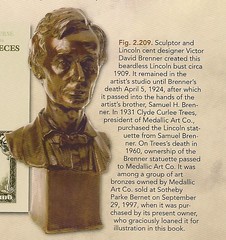 David Hirt mentions the catalog of Irwin Stoff's Brenner collection in last week's E-Sylum. Stoff's Brenner collection was a major part in a celebration tribute to Victor David Brenner. As the date of the centennial of the famed engraver's birth -- June 12, 1871 -- approached, Stoff and I wondered what we could do to celebrate the event. We both collected Brenner medals so we merged our kindred interests and came up with the concept of a massive Brenner medal exhibition. Little did we realize the acceptance of that idea.
David Hirt mentions the catalog of Irwin Stoff's Brenner collection in last week's E-Sylum. Stoff's Brenner collection was a major part in a celebration tribute to Victor David Brenner. As the date of the centennial of the famed engraver's birth -- June 12, 1871 -- approached, Stoff and I wondered what we could do to celebrate the event. We both collected Brenner medals so we merged our kindred interests and came up with the concept of a massive Brenner medal exhibition. Little did we realize the acceptance of that idea.
First I suggested to my boss Bill Louth to issue a Brenner Centennial Medal. "Good idea," he said, "propose the idea to Presidential Art Medals who can sell the medal to collectors." I came up with the idea of using the Brenner's Lincoln portrait on one side -- Medallic Art Company owned this design and had the existing model -- with a self-portrait of Brenner on the other. Brenner had modeled his self portrait in a pallet-shaped medal in 1898 under guidance of Louis Oscar Roty as one of his early modeled designs.
I presented the idea to Jim Harper of Presidential Art. He liked the idea, gave us the green light to proceed. I gave a photo of that self-portrait to Julius Lauth, art director of Medallic Art who commissioned sculptor Rolf Beck to make the model.
Next Irwin and I gather a list of what we could exhibit. His collection was extensive. I was able to add to it what he lacked. I took plaques off the wall at Medallic Art, medals out of exhibit cases, a couple medals out of the storeroom and even had a couple new pieces made from galvano molds and dies we had on hand. I wrote a catalog of the sixty most important pieces by Brenner.
Then Irwin and I had to find a secure place to exhibit it. What would be the best place we could think of in New York City? At that time the Chase Bank had their Money Museum across the street from Rockefeller Center at street level (1254 Avenue of the Americas). This would be our number one choice. We contacted Gene Hessler, curator at the time. HE like the idea as well. We were hitting home runs at every turn. He would empty an entire wall behind glass at the far end of their exhibition display.
With the dimensions of that wall, Irwin and I bought three pieces of plywood to fill the wall. Irwin had his own firm in the garment district. "Can we cover those boards with cloth," I asked him. "Leave that to me," he replied.
On the Saturday before we were to install the exhibit, I laid out the boards on the floor of Medallic Art's showroom. Irwin had acquired (wholesale, of course) an entire bolt of purple velveteen. We cut and fastened this to the boards. We laid out where the medals and plaques were to be located and put nails under these to support the medallic items. A week later we took the prepared boards to the Chase Bank. Set the cloth covered boards in position and placed the medallic items in place.
Meanwhile, I had sent a letter on Medallic Art Company stationery to Eva Adams, Director of the Mint, with my best language making an appeal that we are honoring the U.S. Mint's most famous sculptor on the centennial of his birth. It would be very secure and protected exhibition. Is there anything the Mint would care to exhibit at that time?
Eva Adams and my boss Bill Louth were on extremely good terms (Bill even named her a director of the firm when she retired from the Mint). SHE liked our idea as well. Home run again!
She agreed to send Brenner's original models from the Philadelphia Mint's vault, but also the original galvanos made from his models. These had not been on public exhibition since 1910 when the American Numismatic Society mounted their fame International Exhibition of Contemporary Medals.
But that's not all! She also sent chief engraver Frank Gasparro for opening day! And he brought his original models and galvanos of his 1959 reverse which replaced that year Brenner's original wheat reverse!
Wow! We had no idea such an exhibit of Brenner medallic art would have such an appeal! And that everyone we contacted wanted to assist and aid in the exhibition. Everyone felt the tribute to Brenner was justified.
But that's not all! Before opening day I went into Bill Louth's office and took off the shelf behind his desk a small bust of Abraham Lincoln. It was created by Brenner and bore his signature on the back. I took this to the Chase Bank and got Gene Hessler to open a circular citrine to place the Lincoln bust in the center of the exhibition area.
(There is more to the history to that Lincoln bust. In 1972 new owners of Medallic Art consigned 105 pieces of sculpture for sale at Sotheby's in New York City. I attended that sale and purchased that very Brenner Lincoln. It is on the shelf above my computer as I type this article.)
Opening Day was planned for June 12, 1971 -- the actual centennial day! -- On Sunday, June 6th we had publicity in the New York Times. Tom Haney devoted nearly his entire weekly coin column to this exhibition.
But it was Irwin Stoff's interest in Brenner, and his Brenner medal collection that was the start of all this. He ultimately consigned his Brenner collection to NASCA for sale in their December 6, 1978 auction sale (#16) with a follow-up in sale #19, May 2, 1979.
Question of the week: What do you remember of NASCA? What do the initials stand for, and what about the two principals, Douglas Ball and Herbert Melnick?
To read the earlier E-Sylum article, see: MORE ON BRENNER'S FOOTBALL MEDAL (coinbooks.org/esylum_v14n34a17.html)
WINNER: 2011 "BOOK OF THE YEAR"!
NOTES FROM E-SYLUM READERS: AUGUST 21, 2011
A Harmless Squirrel
James Higby writes:
Regarding the name of one of our Facebook fans, Ecureuil Inoffensif is French for "Harmless Squirrel." What's that all about?
Bank of England Replacement Notes
Regarding Re Dr. Ali Mehilba's proposed book on worldwide replacement notes,
Antoine Scrivener writes:
Anyone attempting to navigate the labyrinthine ways of the replacement notes of the Bank of England would do well to consult Token Publishing's "Banknote Yearbook".
To read the earlier E-Sylum item, see: HELP SOUGHT FOR UPCOMING BOOK ON REPLACEMENT NOTES (www.coinbooks.org/esylum_v14n30a04.html)
Toxic Substances on Paper Money
Regarding toxic substances found on paper money, Leon Saryan, Ph.D. writes:
In toxicology, the dose makes the poison. More poison leads to more adverse effect. The scientists from New York have found a contaminant on money, but do they discuss whether that amount is toxicologically significant? The BPA levels on currency seem miniscule, especially compared with those on the cash register receipts we all receive and handle when making purchases (using a "thin film" of BPA as part of the way the receipt is printed).
If this stuff is toxic, why not go after the more contaminated items--the cash register receipts--rather than pointing a finger at currency? Tell us how much BPA is found on the receipts, and whether that amount is harmful, and whether the receipts should be banned from use.
I have been a toxicologist for thirty years. In almost every instance I can think of, if a big problem is solved the little ones tend to disappear.
If these scientists were the first to find that the thermal receipts were contaminated by BPA, that would be important. Otherwise I am not impressed by the New York study.
To read the earlier E-Sylum item, see: DIRTY MONEY: ALL BANK NOTES ARE TAINTED WITH BISPHENOL A (www.coinbooks.org/esylum_v14n34a21.html)
Abbott Press and Self-Publishing
Regarding my question about Abbott Press, Ginger Rapsus writes:
I have been considering self-publishing for some time now, and I find Abbott Press' prices to be quite expensive. Lulu is cheaper, and there are other POD (print on demand) companies that can do the job for lower prices. Does Abbott Press supply anything else with their publishing package, such as ISBN, editing etc? I highly recommend "The Fine Print of Self-Publishing" by Mark Levine for anyone thinking of self-publishing. BTW, I plan to publish for the Kindle.
To read the earlier E-Sylum item, see: KRAUSE PUBLICATIONS PROMOTES ABBOTT PRESS FOR NUMISMATIC AUTHORS (www.coinbooks.org/esylum_v14n34a14.html)
Handling the Raw Nova Constellatios
Regarding the Nova Constellatio pattern set, Bruce Lorich writes:
Those of us who were on the staff of Bowers & Ruddy Galleries when the Garrett collection was sold had a lot more opportunity to see these famous Nova Constellatio pattern coins than anyone else ever has, other than Garrett himself perhaps, or John Ford. I held each of them in my hands and examined them at length under a glass. I assume that Ford did as well. I also held and felt the heft of each of Garrett's Brasher doubloons. Now they are all embedded or held in plastic, through which their gleam does not come across quite so appealingly as when "naked."
To read the earlier E-Sylum item, see: 1783 NOVA CONSTELLATIO PATTERN COINS ON DISPLAY AT 2011 CHICAGO ANA (www.coinbooks.org/esylum_v14n34a08.html)
More on Coin Presses
Peter Gaspar (E-Sylum subscriber #1) writes:
I enjoyed rereading Dick Johnson's "The History of Coin Presses" originally in the October 3, 2004 E-Sylum and reprinted August 7. Readers interested in the subject might want to read my 11 page plus two plates paper "Coining and Die-Making Techniques in the 17th Century" published in volume 3 of the series "Metallurgy in Numismatics" edited by M.M. Archibald and M.R. Cowell, Royal Numismatic Society Special Publication No. 24, London, 1993.
Unfortunately, do not have an electronic version of the paper, but if I receive several requests for it, I will have it scanned and provide it.
To read the earlier E-Sylum item, see: E-SYLUM'S BEST: THE HISTORY OF COIN PRESSES (www.coinbooks.org/esylum_v14n32a19.html)
Notes From Bob Neale
Bob Neale writes:
[1] Re: 8th Coin World Almanac. I've used my 1st edition (1976, 883 pp) many times and often thought of upgrading to a newer one. I hope that The E-Sylum will publish more reviews of the latest edition with emphasis on things beyond the lack of coverage of medals, which are probably way too extensive for inclusion in what is likely to be the last edition in printed book form. But, I'll probably buy the new Almanac anyway.
[2] The note about Mihm's article in the Boston Globe made me wonder: do any E-Sylum readers regularly, or occasionally, write about numismatics for their local newspapers? That could be quite useful to promote the hobby, especially in those areas of the country where radio and TV pieces are not aired.
[3] There have appeared several suggestions for additions to the 16 U.S. government-authorized minting facilities about which I first inquired in v13 #23 (June 2010) and listed in v13#24. It would be great if someone decides to compile and write an article about the latest (final?) list. Although I do expect to go through the E-Sylum issues to assemble the present list for myself, including Ganz' striking (had to do it) Mint for a Day, I'm not prepared to independently confirm those entries since my original 16, as necessary for publication. It's sufficient for me to take the word of the well-respected numismatists from whom the additional suggestions have come. It's been fun!
THE BOOK BAZARRE
QUERY: THE WHITMAN BLACK BOOK SERIES
Glen McClelland writes:
 I am a collector of the Whitman Black Book series of books published in the early 1960s. The problem is I'm not sure how many titles were published. I have contacted Whitman Publishing to see if they had a list, but they said that their records no longer went that far back.
I am a collector of the Whitman Black Book series of books published in the early 1960s. The problem is I'm not sure how many titles were published. I have contacted Whitman Publishing to see if they had a list, but they said that their records no longer went that far back.
I recently saw that Joel Orosz has a new column in Coin World dedicated to books on numismatics so I contacted him and asked if he knew how many different titles there were. He wrote back saying he had wondered the same thing himself. He also suggested that I contact you to see about publishing a list in The E-Sylum. Attached is a list of the titles I have. Do any of your readers know of other titles?
Alaska's Coinage Through the Years By Maurice M. Gould and Kenneth Bressett
The Colonial Coinage of The U.S. Virgin Islands By Lincoln W. Higgie
Confederate States Paper Money By Arlie R. Slabaugh
Foreign Coins Struck at the United States Mints By Charles G. Altz and E.H. Barton
A Guide Book Of United States Fractional Currency By Matt Rothert
Hawaiian Coins, Tokens and Paper Money By Maurice M. Gould and Kenneth Bressett
Moneys of the Bible By R.S. Yeoman
The Money of Puerto Rico By Maurice M. Gould and Lincoln W. Higgie
Money Tells the Story By Rear Admiral O.H. Dodson
Patriotic Civil War Tokens By George and Melvin Fuld
The Silver Dollars of Africa By John S. Davenport
United States Territorial Coinage for the Philippine Islands By Neil Shafer
A Guide to Civil War Store Card Tokens By George and Melvin Fuld
QUERY: GUIDELINES FOR PUBLISHING BANKNOTE IMAGES IN QATAR
Web site visitor René Preston writes:
Do you know where I can find guidelines for photographing Qatar currency? The photo may be in a book sold in Qatar. So, I want to make sure I follow their guidelines
QUERY: LEWIS COMMISSARY TOKEN INFORMATION SOUGHT
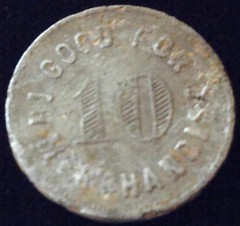

Web site visitor Tammy Granger writes:
I was reading your article about military tokens because I was doing research to see if what I have is a commissary token. I have a token that on one side says what I think is "N. (or H) M Lewis" at the top. "Commissary" in the middle and "Not Transferable" underneath that. The other side says "Good For" around the top then "10" in the middle and "In Merchandise" around the bottom. It is in really rough shape so not sure it would show up well on a photo. I thought maybe you could help me identify it.
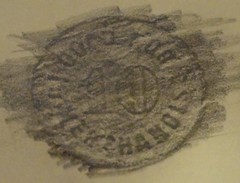
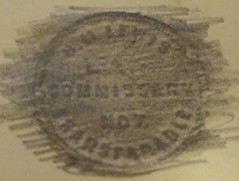
To read the earlier E-Sylum article, see: BOOK REVIEW: MILITARY TOKENS IN 'A GUIDEBOOK OF UNITED STATES TOKENS AND MEDALS' (www.coinbooks.org/club_nbs_esylum_v14n18.html)
KOLBE & FANNING SEPTEMBER 15, 2011 SALE HIGHLIGHTS
Key Works on Various Topics Including
Official Copies of Leonard Holland's 1959 Pennypacker
Large Cent Sale Documentation
A Fine Original Set of Tolstoï's Monnaies Byzantines
Sheridan Downey's 1993 Overton Sale and Downey Sales 10–26
An Original 1957 Contract of the Sale of the
George Mihailovitch Collection of Russian Coins
Catalogue Available soon at Our Web Site: www.numislit.com
Printed Catalogues $10.00
KOLBE & FANNING NUMISMATIC BOOKSELLERS
141 W JOHNSTOWN ROAD, GAHANNA OH 43230-2700
(614) 414-0855 • df@numislit.com • GFK@numislit.com
QUERY: COLONEL CUTTING CONDER TOKEN COLLECTION INFORMATION SOUGHT
Peter Preston-Morley of Dix Noonan Webb writes:
I wonder if one of your knowledgeable subscribers can assist? I'm endeavouring to trace a catalogue for the auction of Conder tokens and other material formed by Colonel Cutting, which I think was in a Lyman Low sale in New York in November 1898. Not having a copy of John Adams's volume on US 19th century sale catalogues to hand, can anyone confirm the date of the auction to me and was anything ever written anywhere on Cutting and his numismatic affairs?
THE H.O. GRANBERG FAMILY AND THE 1804 DOLLARS
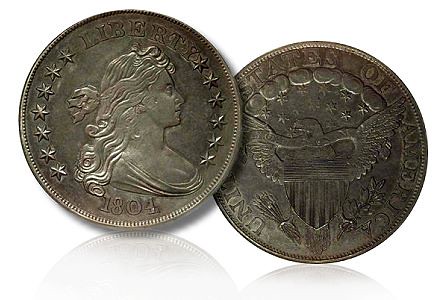
The 1804 Dollar has always been one of the most, if not, the most, written about coin issue ever. Collectors dream about owning one, and most people actually shake with excitement the first time they're able to hold one, even if it's in a holder. I know…I've held a few of them "raw," in other words, unholdered, and have watched others do the same.
But it's the coin's story that gives these circular pieces of metal their excitement. And when you add mystery to history the story gets even more interesting. The complete story of the 1804 Dollar was originally revealed in The Fantastic 1804 Dollar. In more recent years, Whitman Publishing produced a "Tribute Edition" of the same book. This edition has additional chapters that include: "A Remembrance with the Authors" and "Edmund Roberts and the Diplomatic Coins," among others.
Each example has its own story. The Idler specimen, now owned by the American Numismatic Association, was purchased from the estate of the late William Idler in 1908 by H.O. Granberg, of Oshkosh, Wisconsin, my home town. In fact, Granberg and my great grandfather, his personal physician, were personal friends. Many years later, in an unrelated turn of events, I purchased the home of H.O. Granberg and most of its contents.
Curiously, Granberg died about seven years before I was born, but the utility bills and property tax bill were transferred directly from his name to my name, about three dozen years after he died. One of his sons remained living in the home and just kept paying the bills. So, H.O. Granberg's furniture, library, and many other belongings were still in the house when I purchased it, along with most of those items.
On top of a bookshelf in an upstairs bedroom I found several hand written letters written to H.O. Granberg in 1908 from John W. Haseltine and others about the 1804 Dollar owned by the late William Idler of Philadelphia. A few years later I transferred those original letters to Aubrey Bebee, who donated the Idler 1804 Dollar to the American Numismatic Association in 1991. The ANA did not receive those letters along with the donation of the coin, and they are now presumed missing, as Mrs. Bebee could not account for the letters after her husband's death. Copies of these letters will be displayed in the exhibit area at the 2011 Chicago World's Fair of Money in Chicago. More information about the Idler 1804 Dollar and these letters will be found at CoinWeek.com during the coming weeks.
Two years before he purchase the Idler 1804 dollar, H.O. Granberg purchased his first "1804" dated silver dollar. That coin will be displayed at this year's World's Fair of Money in the exhibit area as well. It's not the most eye appealing coin. It's been cleaned and has a large "X" scratched into its reverse. Displayed with this coin will be original documents, like the 1906 receipt from the coin's purchase by H.O. Granberg, several letters describing how the coin was tested at the Philadelphia Mint, and the 1913 B. Max Mehl auction catalog of which this coin was the only coin illustrated on the front cover. The trouble is…this coin is not a real "1804" silver dollar! It's an alteration of an 1800 (B-1) silver dollar in which the last "0" of the date was reshaped into a "4."
This coin was handed down to H.O. Granberg's son, Henry. He kept it in a red flip top case that had two circular depressions in it, suggesting that two silver dollar size coins could be exhibited in this case, which was convenient for displaying the obverse and the reverse of two silver dollars. Henry also had two framed pieces of art from 1887 that documented the 1804 Dollar owned by James V. Dexter. Curiously, the Dexter 1804 Dollar illustrated in the artwork was displayed in a very similar red case exhibiting both the obverse and the reverse of the Dexter 1804 silver dollar in depressions identical to those in the red case. Could this be the same case that's illustrated in this 1887 work of art? Circumstances support this conclusion!
Through research, I have turned up an abundance of information and objects related to the Dexter 1804 Dollar. Some of these items will also be displayed in the exhibit area of the Chicago ANA convention. All three of these coins will be tied together in the exhibit by a common thread – the H.O. Granberg family.
To read the complete article, see:
The King of American Coins – the Dollar of 1804 – Part 1
(www.coinweek.com/coin-guide/coin-profiles/the-king-of-
american-coins-the-dollar-of-1804-part-1/)
QUERY: LANGUAGES AND MARKS ON PORTUGAL'S 2.5 EURO COIN
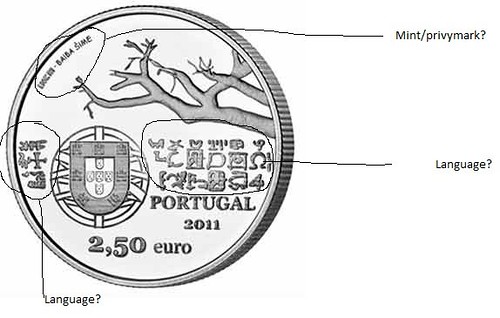
P.K. Saha writes:
Portugal recently issued a 2.5 € coin. What are these languages and mint/ privy marks on this coin? I have received only an incomplete answer so far. It says "Since these explorers explored Africa, these must be some African languages"
TREASURY DOCUMENTS LIST DEADBEATS OF THE PAST

Since last October, the project catalogers creating online rare-book level records for 1801-1820 imprints have been working on United States' federal documents. Admittedly, some government documents are boring. But much more often than I imagined they have been a source of interesting, even surprising, information.
Many documents, but especially Secretary of the Treasury Albert Gallatin's report to the House of Representatives, dated November 6th, 1807, remind us that the questions the country is grappling with today are the same as occupied Congress and government officials two hundred years ago:
On the first day of January, 1809, the principal of the debt, will, if the proposed modification be not assented to by the public creditors, amount to near fifty-seven millions and five hundred thousand dollars … That the revenue of the United States will … be considerably impaired by a war, neither can or ought to be concealed. … It is, on the contrary, necessary … to examine the resources which should be selected, for supplying the deficiency, and defraying the extraordinary expenses. … Whether taxes should be raised to a greater amount, or loans be altogether relied on for defraying the expenses of a war, is the next subject of consideration. …
Depending on one's point of view, knowing this can be oddly reassuring (we've gotten through this before, we can do it again), or the cause for sadness (why don't we learn from history?)
But the documents which have most recently piqued my interest and imagination are three statements from the Comptroller of the Treasury, dated 1814, 1815, and 1817. They report "unsettled balances" remaining on the books of the Treasury Dept. In the 1814 statement, John Chisholm, "conductor of Indians," is listed with a balance of $926.24. The accompanying note reads, "He is not to be found." Was he killed by Indians, did he die of illness or accident en route, or did he take the money and run? In the 1815 statement, Robert Alexander, contractor for building a custom house at New Orleans, is listed with an outstanding balance of $19,000. The note reads, "Custom House built, no account rendered." Lost in the mail? And in the1817 statement, Samuel Sitgreaves, "commissioner under 6th article British treaty," is listed with a balance of $6,857. 20. The note reads, "Advanced by Department of State. No account rendered. Mr. S. alleges that the public is in his debt." Call me a cynic, but what are the odds that this was ever settled?
To read the complete article, see:
John Adams: Deadbeat, careless accountant, or the continuing victim of partisan politics?
(pastispresent.org/2011/good-sources/john-adams-deadbeat
-careless-accountant-or-the-continuing-victim-of-partisan-politics/)
THE BOOK BAZARRE
ALAN WEINBERG ON THE 2011 CHICAGO ANA CONVENTION
The Chicago ANA from Monday afternoon setup til Sat afternoon was impressive, It was difficult to judge attendance by collectors or the public as the bourse floor at 220,000 square feet was immense- by far the largest bourse floor and largest bourse set up in numismatic history.
While I circulated on the bourse floor from one end to the other at least 25 times over this week, I encountered some people often only once if they were not behind a bourse table and in fact often missed friends that I was told had attended. I did notice one thing dramatically different from any other coin show I've attended in the past year or two. An almost total lack of buying and selling bullion. Not one member of the public selling old gold jewelry to a bourse buyer. Not one person buying or selling a quantity of gold or silver bullion coins.
Perhaps this is related to the record high prices of both metals and the public and investors' hesitancy in either buying or selling at these levels. In short, almost all bourse activity was truly numismatic in nature. I heard nary a grumble of the show being slow or disappointing and almost all comments I overheard were mildly or hugely enthusiastic.
There were some comments on the wisdom of returning to Chicago over and over again but the latest Numismatist lays out in detail , I believe for the 1st time, a full explanation of the financial necessity for this. I hate to say it but I was convinced.
The StacksBowers auction sessions I did attend were aggressively bid and crowded, with some fascinating material being offered.
Just a short time before I departed Saturday afternoon I managed to attend 30 mins of Karl Moulton's presentation to the Pioneer Gold group on his forthcoming 700 page or so massive tome on John Ford & Paul Franklin, with the expressed intent of perusing the manuscript and deciding if I wanted to invest the $250 pre-publication price. I decided I would as the half complete color plate manuscript I did examine looked fascinating.
DAVID HARPER ON THE 2011 CHICAGO ANA CONVENTION
When I walk the bourse floor, a great deal of business is obviously being done. The aisles are full of people. Dealer tables have waiting customers. The audible buzz is strong and continuous.
So far so average.
What surprised me yesterday was something I did not expect to see.
Not long before lunch I was passing the booth of the Bureau of Engraving and Printing. This display usually draws crowds. Yesterday when I walked by it looked relatively empty.
The light went on in my brain and I quickly went to the other end of the hall to take a look at the U.S. Mint booth. This, too, is usually a major convention draw. Again, almost no public was present.
Can it be two bad locations or are market conditions so urgent that convention attendees feel there is no time to stroll around and do the usual convention kind of things?
I'll vote for the latter.
This sense of urgency to do business is also affecting the public back home.
I talked to Pat Heller, Lansing, Mich., coin dealer and author of our numismatic e-newsletter. He was leaving the ANA show early to go home to his shop. Activity there, he said, is so frantic, he needs to be there.
Julian Jarvis of Greencastle, Ind., stopped by the Krause Publications table to say hello. He was present at the ANA on a quick in-and-out day trip. He was making appointments by phone for today back at his office as he walked the bourse. Like Pat Heller, his mind was being pulled back to his office instead of being able to fully focus on his mission here.
So whether you are at the ANA or back home, it appears we are all fixated on now. Whatever must be done, it must be done immediately. There is no time to wait, no time to be curious, no time to simply be a collector.
To read the complete article, see: No time to wait (www.numismaticnews.net/buzz/no-time-to-wait)
WAYNE'S NUMISMATIC DIARY: AUGUST 21, 2011
The week was filled with numismatic anticipation for me as I prepared for my first trip to an American Numismatic Association convention in several years. With an entourage including a wife, three kids, two in-laws and a dog we don't travel just to make Dad happy, and going off to a show on my own while my wife is stuck with the kids doesn't fly very well, either. But thanks to a generous travel incentive and a special dispensation from the Mother of All My Kids, I was able to make the annual NBS meeting, the trip to Bill's Numismatic Library, and the ANA banquet.
Earlier in the week I opened some packages that had arrived in the mail. Included were review copies of Whitman's America's Beautiful National Parks and Colt Cylinder Scenes, 1847-1851 by Arthur Tobias. No time to start reading when I had to pack and finish some chores around the house.
On Wednesday I took a few minutes in the afternoon at work to give Eric Newman a call. He was summering at Martha's Vineyard. My 100-year-old numismatic friend was doing well, and we talked a while about The E-Sylum and some of Eric's current research projects. He has a question for our readers, so look for something in a subsequent issue. He hasn't been to an ANA in several years - I'll miss seeing him.
I'll always remember what a delight it was to see him walk through the cabin when my plane going to the 1996 Portland ANA convention had a stopover in St. Louis, Eric's hometown. He recognized me and said hello. After takeoff I sat next to him and we had a delightful conversation about numismatics, his life and family that continued all the way to the terminal.
I left work early on Thursday to get to Dulles airport. I needn't have bothered. My flight was delayed an hour because of stormy weather. Adding insult to injury, once out on the runway they halted all outgoing flights due to the storm. I was still on the plane as it rolled back to the terminal at 10:30pm, over three and a half hours after we were supposed to take off.
It was going to be a long night. The only good thing about it is I was able to pull out my laptop and work on editing The E-Sylum while we waited on the tarmac. I had plenty of time. After a change of crews the plane rolled out from the terminal at midnight, only to be stopped again due to weather. We finally took off at 1:30am. By the time I made it to my room at the Hyatt, it was 4am my time, and I'd been up since 5am.
But I dragged myself out of bed before 9am Friday and walked across the skywalk to the convention center. It was very quiet. I didn't see another soul and one of the air conditioners was making a sound like a cricket chirping. Where was everybody?
I made it to the registration table and walked right up. I thought I recognized Numismatist editor Barbara Gregory behind the counter, but it was her lookalike Christine. We chatted a bit and I got my badge. Not having had breakfast I bought an overpriced bagel and beverage in the lobby. I ate while reviewing the convention program.
When I went in I headed for Bill Burd's table. As luck would have it one of the first people I recognized was Julian Leidman. He was at his table. It seems that every coin show I walk into, he's the first person I run into.
When I got to Bill's table he was busy with a customer and I spoke with his daughter Katherine. There was an empty space where the Nova Constellatio Quint was to be exhibited. When I spoke to Bill he said Walter Perschke had submitted it for slabbing. I'd missed out on a chance to see the coin in the raw. I learned where the library tour bus would be and took a walk around the bourse floor.
 The first familiar face I saw was none other than Howard Daniel, who was manning a club table and recruiting folks for NBS and other organizations. It had been a slow show, at least in that part of the course floor. While he'd talked to a number of people he also had time in between to work a bit on the manuscript for his next book. We'll look forward to seeing it!
The first familiar face I saw was none other than Howard Daniel, who was manning a club table and recruiting folks for NBS and other organizations. It had been a slow show, at least in that part of the course floor. While he'd talked to a number of people he also had time in between to work a bit on the manuscript for his next book. We'll look forward to seeing it!
From there I found John Burns' table and talked for a few minutes. Sorry - I forgot to pull out my camera phone. But I had it handy the rest of the day.
 Next I stopped at the table manned by Joel Orosz and Len Augsburger, where they were selling copies of their new book on the first U.S. Mint. Here's Len with Bill Bugert and Brad Karoleff. I missed getting a great picture of Brad kneeling in supplication before Joel and Len, in honor of their winning the Numismatic Literary Guild's "Book of the Year" award the night before. I was with Brad in his "we're not worthy to be in your presence!" chant...
Next I stopped at the table manned by Joel Orosz and Len Augsburger, where they were selling copies of their new book on the first U.S. Mint. Here's Len with Bill Bugert and Brad Karoleff. I missed getting a great picture of Brad kneeling in supplication before Joel and Len, in honor of their winning the Numismatic Literary Guild's "Book of the Year" award the night before. I was with Brad in his "we're not worthy to be in your presence!" chant...
Never one to stop with just ONE joke, Brad went on to tell Bill and I how excited Len was to learn they'd won. "He jumped up and squealed like a 13-year-old girl at a Justin Beiber concert!". When Len protested that he was exaggerating a little, Brad said, "OK - like a 12-year-old girl." Below is a picture of Joel inscribing a copy of their book.
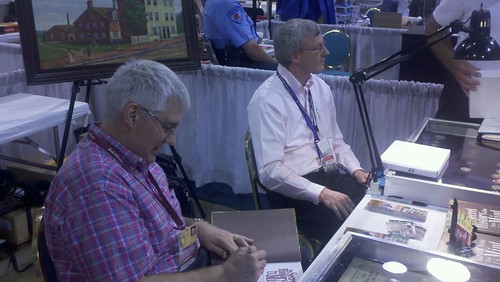
Next to Joel and Len's booth was the Whitman Publications booth displaying the 1783 Nova Constellatio pattern set. With a security guard nearby, this lovely lass in Colonial garb distributed copies of a reprinted Coin World article on the set and how it was reassembled by John J. Ford.
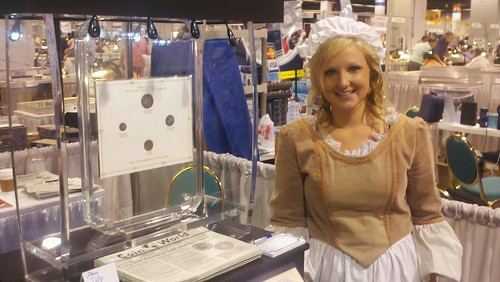
It was hard to see the coins, mounted as they were behind multiple layers of glass and plastic. After confirming it was OK to shine a light on the coins I rummaged thru a compartment in my backpack and pulled out a 3x magnifier and a keychain-sized flashlight. I told the young lady I keep everything in my "Man Purse".
With the light in one hand and glass in the other, I examined the coins as best I could. The accessories helped a lot - I could actually see many details on the coins. Nice and shiny, with mint luster!
Next I ran into Dave Harper & Bob Van Ryzin at the Krause Publications table. Bob was wearing a great bibliophile's tie showing shelf after shelf of nice books. I have the same tie and lamented not bringing it for the banquet. They posed for this picture. QUICK QUIZ: who are the two gentlemen seated behind Dave & Bob?
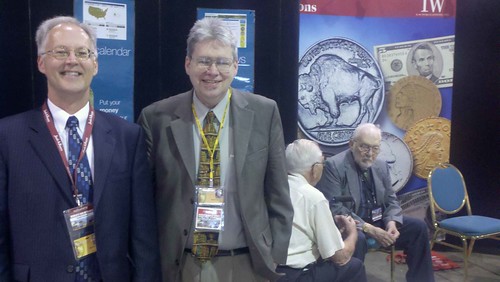
Next I swung by the table of literature dealers Kolbe & Fanning. That's David Fanning on the left, and NBS cofounder George Kolbe on the right. At their table was Kerry Wetterstrom and the three of us talked for a while. I learned that George drew the short straw and would man their table while Dave went to the Bill Burd library tour. But George would attend the NBS meeting.
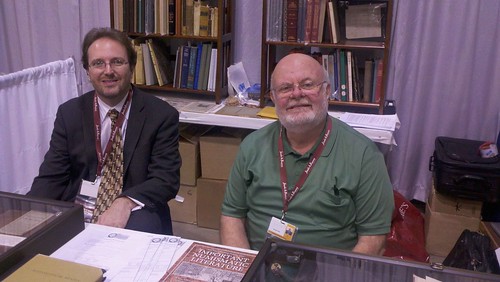
Just down the row was Charlie Davis. He told me about his pencil adventure. Finding himself needing a pencil to write prices in newly purchased inventory, he asked his traveling companion Fred Ouillette to find one. He came back with good news and bad news - he'd found a pencil, but it needed sharpened. After locating a pocket knife Charlie whittled it into service. We talked a bit about rubbings and how no one every seems to need or use a pencil for anything anymore.
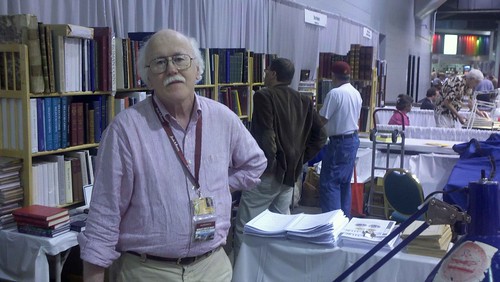
On the way out I stopped again at Bill Burd's table. Luckily, the 1783 Type II Quint was back along with its owner, Walter Perschke. I took a nice close look at the now-slabbed coin, and got this picture of Bill and Walter.
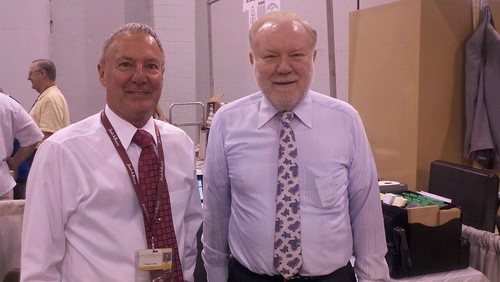
Next up was the Numismatic Bibliomania Society Annual Meeting. I was a bit late after getting lost looking for the room. I took several photos. Here's one of the attendees. See the slideshow below for more. In the room was a Who's Who in U.S. numismatics and numismatic literature including Harvey Stack, Dave Bowers (standing in the photo), John Adams, Dan Hamelberg, David Alexander, Bob Evans and many others. I was pleased to hear several great comments about The E-Sylum and learn that I'd won an award from the Medal Collectors of American for the medal articles Ive edited for The E-Sylum.
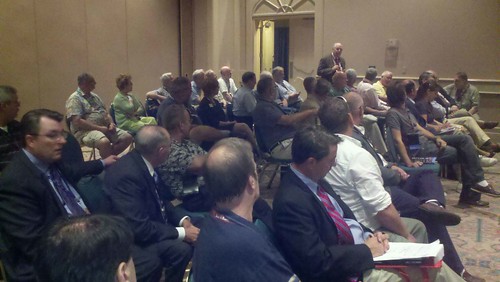
Speakers included Charlie Davis and David Schenkman (talking about Al Hoch of Quarterman Publications), Harvey Stack (on the Stack Family Library), and Elizabeth Hahn of the ANS (on the ANS Library). Following the presentations and talks was the annual NBS fundraising auction. Look for more reports on the meeting in subsequent E-Sylums and Asylum issues.
Next on the agenda was the main event - a tour of Bill Burd's library. I may have more details in subsequent issue, but it's getting late as I write this. Attendees included myself, Bill Burd (of course), Howard Berlin, Amanda Harvey of the ANA, David Sklow, Myron and Darryl Xenos, Elizabeth Hahn of the ANS, Dan Friedus, Fred Reed, David Fanning, Pete Smith, Tom Sheehan and Richard Thompson and his son.
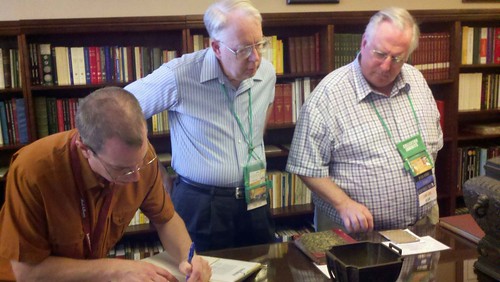
Dan Friedus, Pete Smith, Tom Sheehan
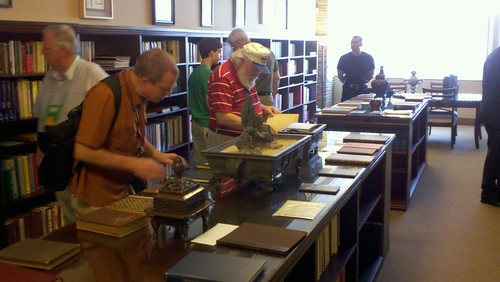
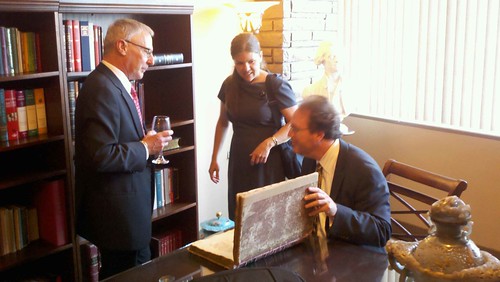
Bill Burd, Elizabeth Hahn, David Fanning
What a great event, graciously hosted by Bill Burd. His library was a delight and a highlight of the convention for all of us in attendance. Thank you, thank you, thank you!
ALTERNATIVE COMPOSITIONS FOR U.S. COINS SOUGHT
Concurrent Technologies Corporation (CTC) has been awarded a competitively bid contract by the United States Mint to conduct research and development for more economical alternative metallic materials for the production of all circulating coins. The award has a contract value of $1.3 million over a two-year period.
"CTC will undertake studies to identify issues with current coinage materials and recommend potential alternative metallic materials for future coins," said Dr. Joseph R. Pickens, CTC Chief Scientist and technical lead for the new contract. "Our metallurgists will consider a wide range of coinage alloys and fabrication processes and propose their best recommendations to the United States Mint." Through outreach with key stakeholders, leveraging research from the United States Mint's extensive coinage experience, and application of the alloy development experience of CTC, the contract's objective is to develop cost-effective solutions that minimize issues for stakeholders who use coinage on a daily basis.
In its recommendations to the United States Mint, CTC will address various factors, such as the effect of new metallic coinage materials on the current suppliers of coinage materials; the acceptability of new metallic materials; costs of metallic material, fabrication, minting, and distribution; metallic material availability and sources of raw metals; coinability; durability; effect on sorting, handling, packaging and vending machines; appearance; risks to the environment or public safety; resistance to counterfeiting; and commercial and public acceptance. "This is a great opportunity for CTC to implement our materials expertise, currently used to solve Department of Defense problems, in an entirely new area," Dr. Pickens said.
To read the complete press release, see:
Concurrent Technologies Corporation Awarded United States Mint Contract to Research Alternative Metals for the Production of U.S. Circulating Coin
(www.prnewswire.com/news-releases/concurrent-technologies-corporation
-awarded-united-states-mint-contract-to-research-alternative-metals-for-
the-production-of-us-circulating-coins-128002458.html)
While eliminating the penny has been debated for decades, it is not a realistic option; the penny has tremendous symbolic value and removing it would have the effect of raising prices — particularly for people of modest means, who use currency the most — because retailers would round up. Reducing the size of the coins is impractical because of the cost of recalibrating vending machines and the need to ensure that the coin is not interchangeable with any foreign coin.
Changing the composition of the penny by using less costly materials is the only feasible alternative. The Mint, part of the Treasury Department, has changed the size or composition of the cent more than a dozen times since 1793. Two of the most recent alterations were the switch to zinc-coated steel in 1943, caused by the wartime shortage of copper, and the switch to zinc with copper plating in 1982, a response to rising commodity prices.
Past debates have brought forth a variety of unconventional suggestions: plastic (used as sales-tax tokens — representing fractions of a cent — in the 1930s, but cheap-looking), industrial porcelain (Germany and Thailand tried this, but it breaks easily); and vulcanite rubber (used as currency in Guatemala early in the last century, but too exotic for American tastes).
Metallic alloys are probably the best choice for a new-composition penny and nickel. The precise choice needs to reflect four values: cost effectiveness, security of supply, aesthetic acceptability and minimal disruption to vending machines. (Pennies are not commonly accepted by machines, but are sometimes inserted anyway; a penny of a different composition could cause machines to jam.)
In a 1976 study of the penny, the Research Triangle Institute rejected chromium, tin, titanium, copper-aluminum-nickel-zinc derivatives and zinc mixtures. At current prices, none of these would be cost-effective. In practical terms, that leaves two basic metallic groups: an aluminum alloy, which is better, heavier and stronger than the pure aluminum cent proposed in the 1970s, but still expensive, and steel, which is the clear favorite for affordability and security, but poses technical challenges.
The best approach is to meld the two. Aluminized steel is ideal because it is available coiled — squeezed by rollers and then put into a lasso-like form that can be fed directly into a coining press. It would work for the penny and the nickel — and the dime, if it is ever threatened.
To read the complete article, see:
Penny Foolish
(www.nytimes.com/2011/08/21/opinion/sunday/
can-we-make-the-penny-affordable.html)
ROYAL MINT TO ISSUE COIN FOR QUEEN'S DIAMOND JUBILEE
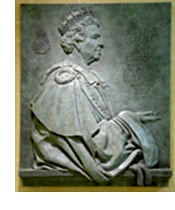

It is revealed that later this year the Royal Mint will be releasing a very special new UK £5 coin to mark the occasion of Her Majesty the Queen's Diamond Jubilee.
This 2012 UK £5 is the official Diamond Jubilee celebration coin, and has now been approved by the Queen and passed by the Privy Council into law as a UK coin.
In 2012 the Queen will become only the second monarch in British history to have achieved 60 years on the throne – the previous and only other time this has happened before was the Diamond Jubilee of the Queen's great-great grandmother Queen Victoria celebrated in 1897.
The final design will be revealed in October 2011, but it was revealed that the obverse will feature a new portrait by Ian Rank Broadley FRBS, the first new portrait of the Queen to appear on a UK coin since 2007, inspired by the sculpture by Mr Rank-Broadley mounted in the entrance to the Supreme Court building on Parliament Square (see image 1)
The reverse will feature an adaptation of the Mary Gillick effigy first used on United Kingdom coins from 1953, by Mr Rank-Broadley and featuring an olive branch and ribbon below. This portrait links the image cleverly back to Queen Victoria's Diamond Jubilee medal struck by the Royal Mint and also to the ‘Una and the lion' coin which was the first coin to depict Queen Victoria and featured a Latin inscription translated as ‘May God direct my steps' (see image 2)
THE COINS OF ANCIENT NEAPOLIS
We took quarters near Kavala. As we know from inscription finds, ancient Neapolis was situated there once, most probably built by Thasos.
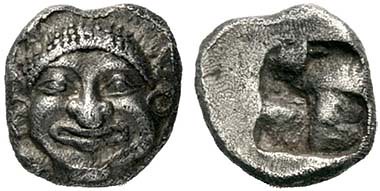
Neapolis. Obol, c. 525-490. Gorgoneion. Rev. Foud-field Quadratum Incusum. From auction Lanz 149 (2010), 101.
We know of many coinages of Macedonian Neapolis so that the idea of a city, being member of the Athenian Alliance with a tribute of only 1,000 drachmai – only a fraction of what Akanthos (18,000 drachmai) or even Terone (36,000 drachmai) were obliged to pay – seems astonishing. Perhaps this modest tribute was the reason why Neapolis was on Athens' side during the Peloponnesian War and was still loyal to Athens in the conflicts with Philipp II. The Macedonian king conquered the city in 355.
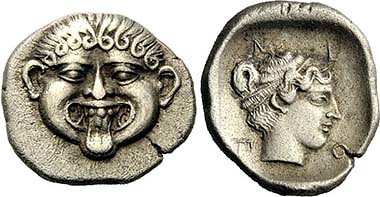
Neapolis. Triobol, late 5th-4th cent. Gorgoneion. Rev. City nymph. From auction Lanz 151 (2011), 346
To read the complete article, see: Numismatic diary of a journey throughout Greece, part 9 (www.coinsweekly.com/en/News/4?&id=735)
FEATURED WEB SITE: NGC COIN EXPLORER
This week's Featured Web Site is the new NGC Coin Explorer from Numismatic Guaranty Corporation. Many thanks to NGC for making this information available to the public.The NGC Coin Explorer is the most comprehensive reference for United States coins. This complete catalog has images and specifications for every U.S. coin, including mintage figures and current melt values for all gold, silver, and platinum coins. Detailed descriptions with insightful analysis are available for almost every coin. NGC certified populations are also displayed in simple chart and graph formats. Collectors—and future collectors—can easily find out how much coins are worth and how their values have changed over time using the integrated NGC Coin Price Guide and actual auction prices realized. NGC Registry scores and an upcoming auctions feature guide future purchases. Like other great online tools from NGC, it's easy to use because of its innovative and intuitive features. Best of all – access to this valuable resource is free to all users.

www.ngccoin.com/NGCCoinExplorer/
